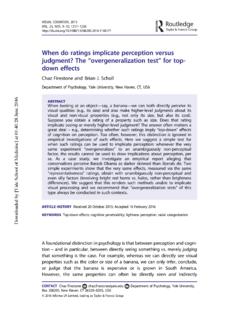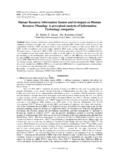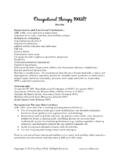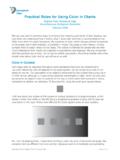Transcription of Research Article ‘‘Perceptual Scotomas’’
1 Research Article perceptual Scotomas A Functional Account of Motion-Induced BlindnessJoshua J. New and Brian J. SchollYale UniversityABSTRACT Inmotion-induced blindness(MIB), salient ob-jects in full view can repeatedly fluctuate into and out ofconscious awareness when superimposed onto certainglobal moving patterns. Here we suggest a new account ofthis striking phenomenon: Rather than being a failure ofvisual processing, MIB may be a functional product of thevisual system s attempt to separate distal stimuli from ar-tifacts of damage to the visual system itself. When a smallobject is invariant despite changes that are occurring to aglobal region of the surrounding visual field, the visualsystem may discount that stimulus as akin to a scotoma, andmay thus expunge it from awareness.
2 We describe threeexperiments demonstrating new phenomena predicted bythis account and discuss how it can also explain several pre-vious of the most exciting phenomena in the study of perceptionarise because of a disconnect between distal stimuli and theirassociated visual percepts. Perhaps nowhere are such discon-nects greater than in the study of visual awareness itself, asobservers can completely fail to be consciously aware of objectsand events that are right in front of them. Vision scientists havenow uncovered many ways to make clearly visible objects andevents invisible in this way (Kim & Blake, 2005). However,most such methods rely on weakening observers visual pro-cessing from the outset by displaying stimuli especially rap-idly ( , in the attentional blink or repetition blindness), toeach eye in a different manner ( , in binocular rivalry), in theperiphery ( , Troxler fading), or in an unexpected mannerwhile attention is otherwise engaged ( , in inattentionalblindness).
3 Recently, however, vision scientists have also un-covered a striking case of stimuli disappearing from awarenessin what seems to be a more pedestrian BLINDNESSIn motion-induced blindness (MIB), a target stimulus may dis-appear and reappear from conscious awareness when it is pre-sented along with a global motion pattern (Bonneh, Cooperman,& Sagi, 2001). This disappearance can occur repeatedly, forsurprisingly salient objects, and even when observers are fullyknowledgeable about the relevant manipulations. Figure 1illustrates a dynamic display that can produce MIB. While theobserver fixates the concentric circles at the center of the dis-play, the target disc in the upper left corner might repeatedlydisappear from awareness for several seconds as the grid ofcrosses rotates.
4 (In the actual color displays, this effect is evenmore striking, because the disappearing target disc is brightyellow and thus even more easily distinguished from the whitefixation circles and dark-blue crosses. Animations of this phe-nomenon and of the other manipulations reported in this articlecan be viewed on-line at )The initial studies of MIB (Bonneh et al., 2001) found that thefrequency or duration of the disappearances could be increasedby manipulating a number of characteristics of both the target( , higher contrast, smaller size, or less motion) and the mask(higher contrast, more mask elements, or greater speed).Since the initial report of this phenomenon, further researchhas characterized its dependence on additional types of lower-level visual properties for example, demonstrating that MIB isenhanced when the target is placed stereoscopically behind themask (Graf, Adams, & Lages, 2002), is interrupted by nearbytransients (Kawabe, Yamada, & Miura, 2007), and is affected byfactors such as target size, boundary length, and target-masksimilarity (Hsu, Yeh, & Kramer, 2004, 2006).
5 At the same time,other results have characterized MIB as a more central example, the targets rendered invisible by MIB can still beprocessed in various ways (Mitroff & Scholl, 2004) fuelingnegative afterimages (Hofstoetter, Koch, & Kiper, 2004) andorientation adaptation (Montaser-Kouhsari, Moradi, Zandvakili,& Esteky, 2004), undergoing grouping (Bonneh et al., 2001), andcontributing to continually updated representations of objectspersisting over time (Mitroff & Scholl, 2005). MIB cannot beAddress correspondence to Joshua New or Brian Scholl, Departmentof Psychology, Yale University, Box 208205, New Haven, CT 06520-8205, e-mail: or SCIENCEV olume 19 Number 7653 Copyrightr2008 Association for Psychological Sciencefully explained by appeal to sensory suppression or adaptation,because it occurs even with slowly moving targets (Bonneh et al.)
6 ,2001), more readily for higher-contrast targets than for lower-contrast targets (Bonneh et al., 2001), and within seconds ofdisplay onset (Hsu et al., 2004). In addition, signal detectionstudies involving stimuli rendered invisible by MIB suggest arole for both decisional processes and sensitivity (Caetta, Gorea,& Bonneh, 2007).Explaining Motion-Induced BlindnessMuch of the interest generated by MIB is due to its mystery: Whydoes it occur at all? Other examples of perceptual disappear-ances can now be largely explained in terms of factors such asinterocular suppression (in binocular rivalry; , Blake, 1989),boundary adaptation (in Troxler fading; , Krauskopf, 1963),lack of attention (in change blindness and inattentional blind-ness; , Mack & Rock, 1998; Rensink, O Regan, & Clark,1997), or delayed attentional engagement (in the attentionalblink; , Nieuwenstein, Chun, van der Lubbe, & Hooge,2005).
7 None of these factors, though, seems to account forMIB in which even moving, attended, and fully visible objectsmay frequently disappear. To date, we can distinguish fourapproaches that address various aspects of MIB: Attentional competition. Inspired by similarities between MIBand impairments of visual awareness such as simultanagnosia( , Rafal, 1997), Bonneh et al. (2001) initially suggestedthat MIB may reflect a disruption of the attentional compe-tition that normally determines what observers are and are notaware of. In MIB, this disruption may be due to the salienceof the mask, which slows attentional shifts and producesa winner-take-all competition for awareness (Bonneh et al.)
8 ,2001; Keysers & Perrett, 2002). Interhemispheric rivalry. Because MIB shares features such asoscillation dynamics with binocular rivalry (Bonneh et al.,2001; Carter & Pettigrew, 2003), the same underlying inter-hemispheric competition may contribute to both phenomena(Carter & Pettigrew, 2003; Funk & Pettigrew, 2003). Thispossibility is supported by evidence that transcranial magneticstimulation can enhance or disrupt MIB depending on thehemisphere to which it is applied (Funk & Pettigrew, 2003). Boundary adaptation. Analogies between MIB and percep-tualfilling inhave suggested to some researchers that thesame underlying mechanism of boundary adaptation may beinvolved in both phenomena (Hsu et al.
9 , 2004, 2006). Surface completion. Inspired by the demonstration that therelative stereoscopic depth of the mask and target can affectMIB, other researchers have suggested a link to visual surfaceprocessing: Perhaps the mask elements are integrated into asingle visual surface, which is then taken to occlude the statictarget underneath (Graf et al., 2002).Each of these accounts has been supported by impressive ex-perimental demonstrations, and the perspective we offer in thisarticle is not meant to compete with them. However, we suggestthat these accounts do a better job of explaining the details ofhowMIB works than ofwhyit occurs in the first place, perhapsbecause many of them are closely tailored to specific experi-mental results.
10 Of course, these accounts are not mutually ex-clusive, and several of them may be combined, but evencollectively they still do not give a clear sense of why MIBoccurs. One reason for this may be that some of these accountstreat MIB at least implicitly as afailureof visual processing due to overloaded attention, sensory overstimulation, or inter-hemispheric competition, for example. In contrast, we suggestthat MIB could represent afunctionalresponse in visual pro-cessing; that is, it may be an example of the implicit logic ofperception (Rock, 1983), rather than a failure to cope with thevisual input in some frames of a typical motion-induced blindness display (not to scale). Observers fixate the center circles while attending to thetarget disc in the upper left quadrant.









